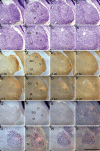Gene expression identifies distinct ascending glutamatergic pathways to frequency-organized auditory cortex in the rat brain
- PMID: 23136415
- PMCID: PMC3752138
- DOI: 10.1523/JNEUROSCI.1310-12.2012
Gene expression identifies distinct ascending glutamatergic pathways to frequency-organized auditory cortex in the rat brain
Abstract
A conserved feature of sound processing across species is the presence of multiple auditory cortical fields with topographically organized responses to sound frequency. Current organizational schemes propose that the ventral division of the medial geniculate body (MGBv) is a single functionally homogenous structure that provides the primary source of input to all neighboring frequency-organized cortical fields. These schemes fail to account for the contribution of MGBv to functional diversity between frequency-organized cortical fields. Here, we report response property differences for two auditory fields in the rat, and find they have nonoverlapping sources of thalamic input from the MGBv that are distinguished by the gene expression for type 1 vesicular glutamate transporter. These data challenge widely accepted organizational schemes and demonstrate a genetic plurality in the ascending glutamatergic pathways to frequency-organized auditory cortex.
Figures








Similar articles
-
Thalamocortical pathway specialization for sound frequency resolution.J Comp Neurol. 2011 Feb 1;519(2):177-93. doi: 10.1002/cne.22501. J Comp Neurol. 2011. PMID: 21165970
-
"Ventral" area in the rat auditory cortex: a major auditory field connected with the dorsal division of the medial geniculate body.Neuroscience. 2006 Sep 1;141(3):1553-67. doi: 10.1016/j.neuroscience.2006.04.037. Epub 2006 Jun 5. Neuroscience. 2006. PMID: 16750887
-
Regional and laminar distribution of the vesicular glutamate transporter, VGluT2, in the macaque monkey auditory cortex.J Chem Neuroanat. 2009 Oct;38(2):106-16. doi: 10.1016/j.jchemneu.2009.05.002. Epub 2009 May 14. J Chem Neuroanat. 2009. PMID: 19446630 Free PMC article.
-
Specific and nonspecific plasticity of the primary auditory cortex elicited by thalamic auditory neurons.J Neurosci. 2009 Apr 15;29(15):4888-96. doi: 10.1523/JNEUROSCI.0167-09.2009. J Neurosci. 2009. PMID: 19369557 Free PMC article.
-
Chemically defined parallel pathways in the monkey auditory system.Ann N Y Acad Sci. 2003 Nov;999:218-33. doi: 10.1196/annals.1284.033. Ann N Y Acad Sci. 2003. PMID: 14681146 Review.
Cited by
-
Quantitative map of multiple auditory cortical regions with a stereotaxic fine-scale atlas of the mouse brain.Sci Rep. 2016 Feb 29;6:22315. doi: 10.1038/srep22315. Sci Rep. 2016. PMID: 26924462 Free PMC article.
-
Neural spike-timing patterns vary with sound shape and periodicity in three auditory cortical fields.J Neurophysiol. 2016 Apr;115(4):1886-904. doi: 10.1152/jn.00784.2015. Epub 2016 Feb 3. J Neurophysiol. 2016. PMID: 26843599 Free PMC article.
-
Effects of location and timing of co-activated neurons in the auditory midbrain on cortical activity: implications for a new central auditory prosthesis.J Neural Eng. 2014 Aug;11(4):046021. doi: 10.1088/1741-2560/11/4/046021. Epub 2014 Jul 8. J Neural Eng. 2014. PMID: 25003629 Free PMC article.
-
Two types of auditory glutamatergic synapses and their implications for repairing damaged central auditory pathways.Neural Regen Res. 2014 May 15;9(10):1000-2. doi: 10.4103/1673-5374.133158. Neural Regen Res. 2014. PMID: 25206751 Free PMC article. No abstract available.
-
Auditory midbrain implant: research and development towards a second clinical trial.Hear Res. 2015 Apr;322:212-23. doi: 10.1016/j.heares.2015.01.006. Epub 2015 Jan 20. Hear Res. 2015. PMID: 25613994 Free PMC article. Review.
References
-
- Arnault P, Roger M. Ventral temporal cortex in the rat: connections of secondary auditory areas Te2 and Te3. J Comp Neurol. 1990;302:110–123. - PubMed
-
- Barroso-Chinea P, Castle M, Aymerich MS, Pérez-Manso M, Erro E, Tuñon T, Lanciego JL. Expression of the mRNAs encoding for the vesicular glutamate transporters 1 and 2 in the rat thalamus. J Comp Neurol. 2007;501:703–715. - PubMed
-
- Basbaum AI. A rapid and simple silver enhancement procedure for ultrastructural localization of the retrograde tracer WGAapoHRP-Au and its use in double-label studies with post-embedding immunocytochemistry. J Histochem Cytochem. 1989;37:1811–1815. - PubMed
-
- Budinger E, Scheich H. Anatomical connections suitable for the direct processing of neuronal information of different modalities via the rodent primary auditory cortex. Hear Res. 2009;258:16–27. - PubMed
-
- Cant NB, Benson CG. Multiple topographically organized projections connect the central nucleus of the inferior colliculus to the ventral division of the medial geniculate nucleus in the gerbil, Meriones unguiculatus. J Comp Neurol. 2007;503:432–453. - PubMed
Publication types
MeSH terms
Substances
Grants and funding
LinkOut - more resources
Full Text Sources
